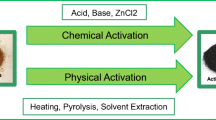The structural characteristics of catalytic systems obtained by modification of activated carbon with Al and Ni metal oxides were studied. The activated carbon was modified by impregnation with metal hydroxides from solutions of salts with Ni+2/Al+3 ratios of 2:1 and 3:1 followed by calcination in a stream of nitrogen and hydrogen until oxide phases were formed. With increase in the ratio of metal cations in the impregnating solution in activated carbon the specific surface area and the number of micropores increase while the total volume and average diameter of the pores decrease. Calcination in a stream of hydrogen at the concluding stage of modification of the activated carbon leads to decrease of the pore space and decrease of the specific surface area of the catalytic system. The Ni/Al (2:1) catalytic systems obtained in nitrogen and hydrogen have the optimum combination of specific surface values and maximum average pore diameters for the treatment of heavy oil residue.

Similar content being viewed by others
References
M. Erturk, Renewable and Sustainable Energy Reviews, 15, No. 6, 2766-2771 (2011).
S. H. Hosseini, G. H. Shakouri, Energy Policy, 91, 64-74 (2016).
D. L. Greene, J. L. Hopson, J. Li, Energy Policy, 34, No. 5, 515-531 (2006).
S. M. Petrov, Chemistry and Technology of Fuels and Oils, 57, No. 6, 895-900 (2022).
A. G. Safiulina, R. R. Zabbarov, S. I. Khusnutdinov, et al., Chemistry and Technology of Fuels and Oils, (2018) 54, No. 3, 265-270 (2018).
J. Laherrere, C. A. S. Hall, R. Bentley, Current Research in Environmental Sustainability, 4, 100174 (2022).
S. H. Mohr, G. M. Evans, Energy Policy, 38, No. 1, 265-276 (2010).
F. Zhao, Y. Liu, N. Lu, et al., Energy Reports, 7, 4249-4272 (2021).
R. O. Caniaz, S. Arca, M. Yaşar, et al., The Journal of Supercritical Fluids, 152, 1-10 (2019).
J. Ancheyta, M. S. Rana, V. Sa, et al., Fuel, 86, 1216-1231 (2007).
H. C. Lee, S. K. Park, Applied Chemistry for Engineering, 27, 343-352 (2016).
N. N. Petrukhina, G. P. Kayukova, G. V. Romanov, et al., Chemistry and Technology of Fuels and Oils, 4, 30-37 (2014).
A. Mejean, C. Hope, Energy Policy, 60, 27-40 (2013).
S. M. Petrov, D. A. Ibragimova, Y. I. I. Abdelsalam, et al., Petroleum Chemistry, 56. No. 1, 21-26 (2016).
I. N. Zaidullin, A. N. Pitsenko, A. G. Safiulina, et al., Chemistry and Technology of Fuels and Oils, 54, No. 5, 550-556 (2018).
A. G. Safiulina, M. Abaas, A. I. Lakhova, et al., International Multidisciplinary Scientific GeoConference Surveying Geology and Mining Ecology Management, SGEM, 18, 405-412 (2018).
A. Nosova, S. Petrov, A. Safiulina, et al., Petroleum Science and Technology, 36, No. 13, 1001-1006 (2018).
S. M. Petrov, D. A. Ibragimova, A. G. Safiulina, et al., Journal of Petroleum Science and Engineering, 159, 497-505 (2017).
S. M. Petrov, G. P. Kayukova, A. I. Lakhova, et al., Chemistry and Technology of Fuels and Oils, 52, No. 5, 619-625 (2016).
M. J. Angeles, C. Leyva, J. Ancheyta, et al., Catalysis Today, 220-222, 274-294 (2014).
O. Muraza, A. Galadima, Fuel, 157, 219-231 (2015).
E. G. Moiseeva, A. I. Lakhova, S. M. Petrov, et al., Chemistry and Technology of Fuels and Oils, 57, No. 5, 746-752 (2021).
L. E. Foss, G. P. Kayukova, B. P. Tumanyan, et al., Chemistry and Technology of Fuels and Oils, 2, 19-23 (2017).
G. P. Kayukova, V. P. Morozov, R. R. Islamova, et al., Chemistry and Technology of Fuels and Oils, 51, No. 1, 117-126 (2015).
A. I. Lakhova, S. M. Petrov, N. Y. Bashkirtseva, Chemistry and Technology of Fuels and Oils, 58, No. 1, 1-5 (2022).
J. Li, Y. Chen, H. Liu, et al., Energy & Fuels, 27, No. 5, 2555-2562 (2013).
A. Lakhova, A. Valieva, A. Nosova, et al., IOP Conference Series: Earth and Environmental Science, 516, 12041.
S. M. Petrov, A. G. Safiulina, N. Y. Bashkirtseva, et al., Processes, 9, No. 2, 256 (2021).
G. P. Kayukova, A. T. Gubaidullin, S. M. Petrov et al., Energy & Fuels, 30, No. 2, 773-783 (2016).
A. I. Lakhova, A. G. Safiulina, G. G. Islamova, et al., Process, 9, 553 (2021).
E. G. Moiseeva, A. S. Il’menskii, K. A. Mishagin, et al., Chemistry and Technology of Fuels and Oils, 58, No. 2, 283-288 (2022).
O. Morelos-Santos, A. I. Reyes de la Torre, J. A. Melo-Banda, et al., Catalysis Today, 392-393, 60-71 (2022).
M. A. Suwaid, M. A. Varfolomeev, A. A. Al-Muntaser, et al., Fuel, 312, 122914 (2022).
C. Li, W. Huang, C. Zhou, et al., Fuel, 257, 115779 (2019).
L. R. Baibekova, S. M. Petrov, I. I. Mukhamatdinov, et al., International Journal of Applied Chemistry, 11, No. 5, 593-599 (2015).
M. R. Gray, H. W. Yarranton, M. L. Chacon-Patiño, et al., Energy and Fuels, 35, No. 22, 18078-18103 (2021).
Acknowledgments
The investigation was conducted using equipment of the Center of Complex Program «Nanomaterials and Nanotechnologies» of the Kazan National Research Technological University.
The research was conducted out of the Russian Science Foundation Grant No. 18-77-10023, https://rscf.ru/project/18-77-10023/
Author information
Authors and Affiliations
Corresponding author
Additional information
Translated from Khimiya i Tekhnologiya Topliv i Masel, No. 1, pp. 25–28 January–February, 2023.
Rights and permissions
Springer Nature or its licensor (e.g. a society or other partner) holds exclusive rights to this article under a publishing agreement with the author(s) or other rightsholder(s); author self-archiving of the accepted manuscript version of this article is solely governed by the terms of such publishing agreement and applicable law.
About this article
Cite this article
Moiseeva, E.G., Maksumova, R.R., Petrov, S.M. et al. Synthesis and Investigation of Nickel–Aluminum Catalyst for Treatment of Heavy Oil Residue. Chem Technol Fuels Oils 59, 28–32 (2023). https://doi.org/10.1007/s10553-023-01498-5
Published:
Issue Date:
DOI: https://doi.org/10.1007/s10553-023-01498-5




